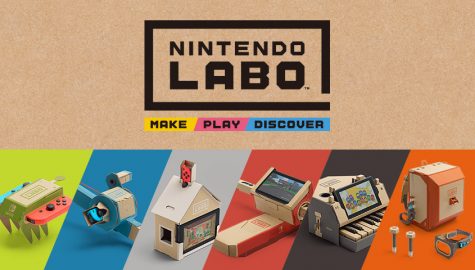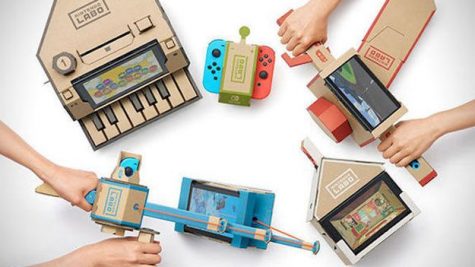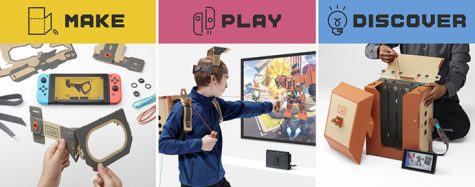Nintendo Labo, the Future of Gaming is… Cardboard?
May 29, 2018
I’m going to say this now: I love Nintendo and have loved Nintendo for as long as I’ve been playing video games. They bring so much innovation and new ideas to the whole gaming scene that it’s no wonder why they’re thriving to this day. From the NES that saved the gaming industry with a mere 8-bits and an Italian plumber to the revolutionary Wii with the first example of stepping into a more immersive future in the way we play video games thanks to the console’s motion controls. Those familiar with the huge developers are well aware that they enjoy calling back to their days of old, back before the production of video games had begun. Many are aware of the production of toys like the Ultra Hand and their infamous Hanafuda cards, but does anyone remember their papercraft products? They were these elaborate little kits that could be put together to create animals, buildings, and more out of mere paper. Huh, Nintendo creating something that’s made of paper in which the consumer has to fold and connect pieces together to get a product? Now where have I heard that- oh wait, they’re at it again!

Yes, the Nintendo Labo; never before have I been so intrigued and yet confused by something Nintendo has announced. First, we were given the incredibly versatile Nintendo Switch, and now… this. For those out of the loop, the Labo are essentially carboard sheets that include pieces which are to be punched-out and put together to receive a neat gaming peripheral. As of the publication of this article, there is the variety kit (which includes a house, a fishing rod, motorcycles handlebars, an RC “car”, and a piano) and the robot kit (which includes a visor, gloves, boots, and a pack which, when constructed and connected, simulate controlling a giant robot). Sounds cool, right? Well, if you want to sink your teeth into this glorified cardboard erector set, you’ll be dropping about $150 total… on cardboard. I’m guessing you can now see why exactly so many people were not only skeptical, but less than on-board after hearing of the high price tag. Luckily, I’m here to tell you as someone who actually got it exactly how poor of a choice it was to pay that much for cardboard.

Let’s start where I’m sure everyone is probably focusing upon: the quality of the material. Unfortunately, it’s kind of lackluster. I’m aware that it can only be so sturdy as to allow the ability to fold and crease, but the material itself feels kind of cheap. Surprisingly, it still served its purpose rather well. Anyways, the way in which they are constructed is by following the step-by-step, instructions given not by 50 feet of paper, but thankfully its through interactive instructions included on the game cartridge that comes with the corresponding kit. They feature build times, a rotatable camera, the ability to freeze or rewind the directions, and even offer time between sections to take a breather since pieces such as the house and piano can be pretty lengthy in terms of time it takes to complete with the robot kit following suit.
Now, onto the games. I’ll be honest, I was kind of disappointed with most of them. The RC “car” (which doesn’t even look like a car) has a nifty camera on the front of it via the Joy-Cons connected to it and is about as simple as it gets. The closest thing you get to an actual game is a stopwatch. As for the house, you’re given an unidentifiably adorable creature that you can play minigames with via the buttons that can be inserted into the house, all of which earn you treats for it. Again, nothing too groundbreaking. The motorcycle and fishing rod are both about as simple as it may sound, but they’re both pretty relaxing and is fun to use. The piano is pretty self-explanatory and rather fun since it gives you a significant amount of freedom to mess around and experiment with what you’re given. I’ll be honest, I haven’t dabbled in most of these for too long, but from what I’ve experienced so far, the variety kit is a bit of a letdown.

Finally, we move onto the robot kit. This is where the real fun lies, but it’s also one of the most complicated things I’ve ever put together, which is saying a lot since I put a PC together for the first time last summer, and that was even with the help of a friend. However, an hour or two later, and it was finally complete. How does it compare? I’ve got to say, it’s pretty fun. Mind you, I feel as if $80 is a bit much for this, but I genuinely had a good time with the game that accompanied it. The premise of it is about as simple as can be: you’re piloting a giant robot and there’s stuff you need to destroy. Have fun. Of course, the suit itself is controlled via the player actually performing certain movements. As for how the gameplay fairs, it has a nice variety, but it just feels a little empty after a while. The possibilities for this thing are actually pretty open, but after a few challenge levels, it gets kind of old.

So, what’s the verdict? I think that it’s definitely a cool concept. That being said, I don’t think it was meant to be quite so ambitious; I mean really, $150 for both?! I understand that it’s really complex and admittedly a cool idea, but this just felt like a one-off thing. Should you get it? Unless you’re a die-hard Nintendo fan or have the creativity of an excelling art student, I wouldn’t recommend it since the span of as far as you can take the Labo equipment and parts only goes as far as your creativity will since the kits allow you to really go above and beyond what’s provided. With that in mind, it’s still expensive carboard. All I’m saying is that since Nintendo showed off a Labo camera, that better mean we’re finally getting a long-awaited sequel to Pokémon Snap with a rather appropriate “Toy-Con” peripheral.

